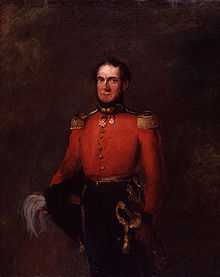John Gurwood

Colonel John Gurwood CB (1790 – 25 December 1845), British Army soldier, began his career in a merchant's office, but soon obtained an ensigncy in the 52nd (Oxfordshire) Regiment of Foot (1808).
Life
With his regiment he served in the "Light Division" of Wellington's army throughout the earlier Peninsular campaigns, and at Ciudad Rodrigo (19 January 1812) he led one of the forlorn hopes and was severely wounded. For his gallant conduct on this occasion Wellington presented Gurwood with the sword of the French governor of Ciudad Rodrigo.[1]
A little later, transferring to the 9th Light Dragoons, he was made brigade-major to the Guards' cavalry which had just arrived in the Peninsula. In the latter part of the war he served as brigade-major to Lambert's brigade of the sixth infantry division, and was present at the various actions in which that division played a conspicuous part— the Nivelle, the Nive, Orthes and Toulouse. In 1814, he transferred to the 10th Hussars.[1]
At Waterloo Captain Gurwood was for the third time severely wounded, although this happened in a preliminary skirmish as a result of which he was sent back to Brussels and missed most of the battle to his considerable mortification.
Gurwood married Fanny Mayer (née Kreilsamner) whom he had met in Paris after the war and whose daughter Eugenie (aged 10 at the time) is now believed to have been the illegitimate daughter of Napoleon Bonaparte himself. Eugenie went on to marry William Baliol Brett, 1st Viscount Esher.
In the first twelve years of the peace he was promoted up to the grade of lieutenant-colonel, and in 1841 became brevet-colonel. He helped broker the so-called Lord Eliot Convention in Spain, which aimed to end the indiscriminate executions by firing squad of prisoners of both sides of the First Carlist War.[1]
He was for many years the duke of Wellington's private secretary, and was entrusted by him with the collection and editing of the Wellington Despatches, which occupied Gurwood from 1837 to the end of his life.[1] [2]
This work is a monument of industrious skill, and earned its author a Civil List Pension of £200. But overwork and the effects of his wounds had broken his health, and following a very public row with William Napier who had questioned Gurwood's bravery at Ciudad Rodrigo, he committed suicide on Christmas Day 1845, by cutting his own throat. He was a CB and deputy-lieutenant of the Tower.[1]
References
- Attribution
 Chisholm, Hugh, ed. (1911). "Gurwood, John". Encyclopædia Britannica (11th ed.). Cambridge University Press.
Chisholm, Hugh, ed. (1911). "Gurwood, John". Encyclopædia Britannica (11th ed.). Cambridge University Press.
External links
![]() This article incorporates text from a publication now in the public domain: Chisholm, Hugh, ed. (1911). Encyclopædia Britannica (11th ed.). Cambridge University Press.
This article incorporates text from a publication now in the public domain: Chisholm, Hugh, ed. (1911). Encyclopædia Britannica (11th ed.). Cambridge University Press.
|